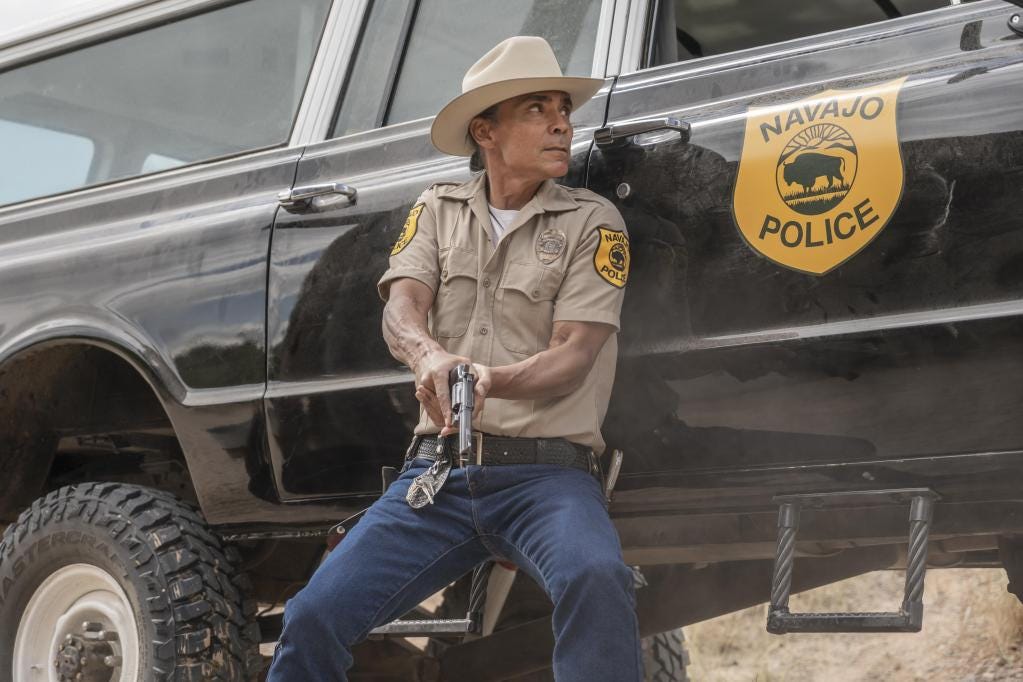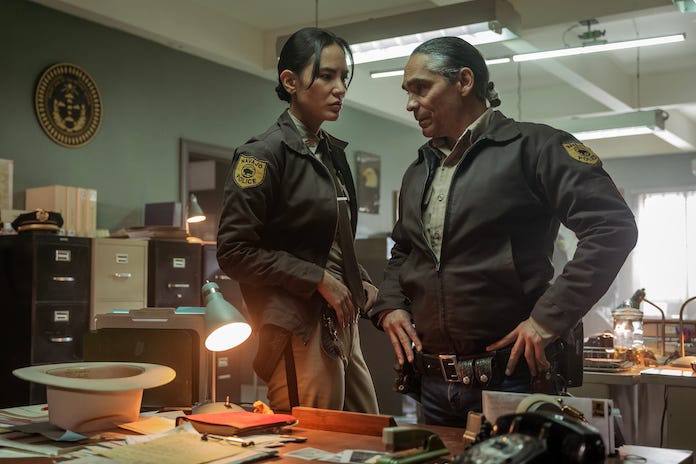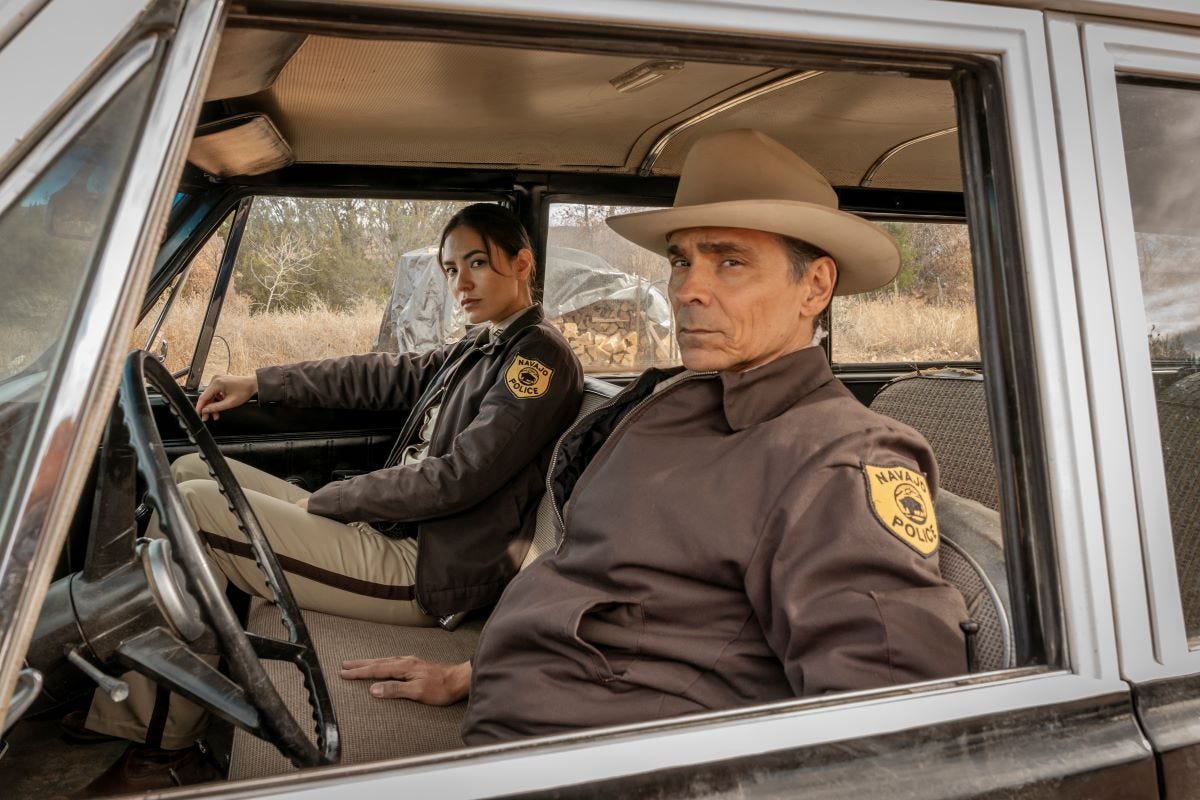TV: Dark Winds – Season 1 (2022) and Season 2 (2023)
A dedicated Navajo cop tries to bring order to a New Mexico reservation in crisis
Joe Leaphorn (Zahn McClarnon) is the Navajo top cop with a mountain lion’s courage
TV: Dark Winds – Season 1 (2022) and Season 2 (2023)
Streaming on Netflix
Season 1 of this series was such a hit with critics and audiences that a renewal for Season 2 quickly followed. The AMC network, the original presenters, were supported by Robert Redford and George R.R. Martin, both serving as executive producers.
Redford had backed earlier filmed versions of novels by Tony Hillerman set in New Mexico, and Martin, who regularly spends time in the state, was a staunch proponent of Hillerman’s work.
Now, watching both seasons back-to-back on Netflix, in six episodes per season, we can appreciate the 12 episodes’ accumulating power. Unfolding on Navajo tribal lands in the early 1970s, they’re drawn from two Hillerman novels, The Listening Woman and People of Darkness.
In all he wrote 18 novels chronicling the Navajo Nation. (He died in 2008, and his daughter Anne has continued writing the series. She’s an executive producer here.)
Which means there’s a rich store for the show’s creators to dig into. And they’re more than up to the task.
The entire writing staff, and most of those working behind the camera, are Native American, and their imprint is on all the details, from artifacts to tribal language and customs, to the Navajos’ shared suspicion of the wider white world.
The heroic center is Navajo Nation police chief Lieutenant Joe Leaphorn, played with star-making nuance and fierce inner light by Zahn McClarnon. Based in the modest town of Kayenta, with a limited staff and next to no forensic assets, Leaphorn tries to uphold justice within 27,000 square miles of New Mexico desert.
A proud Navajo, he understands the restive Navajo population he polices but can’t avert interference from a surrounding white culture that holds Native people and culture in backhanded contempt. Quixotic and tough, Leaphorn counts on two stalwart members of his force.
Jim Chee (Kiowa Gordon) is a Navajo returning to New Mexico after nine years, some of them spent earning a bachelor’s degree at UC Berkeley. Though he claims to have only limited police experience, he persuades Leaphorn to hire him as a deputy.
Chee is actually working undercover for the FBI, which Leaphorn quickly figures out, and once he tells Chee, they agree to work together.
Less sure about Chee’s loyalty is Bernadette Manuelito (Jessica Matten), Leaphorn’s current right arm and a woman eager to climb the ranks of law enforcement. She’s not impressed with Chee’s sudden return to his Native roots. That their “friction” glides slowly toward possible romance hardly comes as a surprise.
Bernadette Manuelito (Jessica Matten) brings smarts and bravery as Leaphorn’s backup
The trio is caught up in two knotty cases. At the opening, a wild and crazy bank heist, pulled off by masked armed bandits who descend in a helicopter and leave two dead guards behind, ends with the chopper heading off for Navajo territory. Were the thieves Navajo?
Since the robbers committed homicide, the FBI has to be brought in, and their man Whitover (Noah Emmerich) wants the glory that will come to him with the bandits’ capture, never mind the fallout for the Navajo community.
He laughingly calls Leaphorn “Kemosabe” and Chee “Tonto”, and, though Emmerich overdoes the racist sliminess, we understand that the Navajo have no friends in Washington. Chee lets the condescending FBI bully know that his always skeptical attachment to the Bureau is withering fast.
The other troubling case is the murder of a young girl and her grandfather. She was literally frightened to death by their assailants, and her grandfather’s eyes were gouged out. Her grandmother survived but is too shell-shocked even to talk.
Could that gruesome attack somehow be linked to the bank robbery? A Navajo terrorist group may be the connection.
But solving these two crimes isn’t the sole focus of the six episodes. The series also wants to portray Navajo culture and its struggles to be respected.
We see Joe’s wife Emma (Deanna Allison), a nurse, try to protect Navajo women from being involuntarily sterilized, a ghastly undertaking to limit the Native population. The practice – it’s not made clear if it was government sanctioned – continued from the late 1960s well into the ’70s.
Navajo young men go fight in Vietnam for lack of opportunities on the reservation. And Navajo people’s persistent resorting to witchcraft and reliance on superstitious forms of revenge complicate Leaphorn’s job, since many are reluctant to rely even on Navajo police to right wrongs.
Warm moments like a young woman's menarche ceremony are beautifully performed and shot, but the community still isn’t free from exploitation.
Overarching the first season is a still unsolved mining explosion which killed six men – including Leaphorn’s son. That agonizing, unexplained loss extends Leaphorn’s thirst for justice into Season 2.
In Season 2’s Episode 3, I noted that a new director, Michael Nankin, was at the helm, and what a difference he and his team make. Nankin quite obviously — with an abundance of gleeful filmmaker’s flourishes — lays the series’ “cultural” agenda aside, and goes for headlong, claustrophobic dread.
There he faces a new, darker enemy. At the opening, Leaphorn and Bernadette are closing in on a deadly, wickedly crafty new suspect. He’s Colton Wolf (Nicholas Logan), a cold-blooded assassin.
They think they have him trapped in his large mobile home, but he exits unseen through a small door, and when they enter, Wolf from outside fires his automatic assault rifle in a hail of bullets. The officers are saved only by diving to the floor. Wolf escapes, and the hunt is on.
What is Wolf’s game? We don’t find out until Episode 3. In the meantime, Chee, now a private eye, is hired by the wife of a millionaire white rancher with ties to a militant Navajo terrorist group, a peyote cult ominously called The People of Darkness.
She wants to know what’s in her husband’s stolen safe. Chee suspects that her husband is in league with The People of Darkness.
Chee is correct, and Wolf aims to help secure the millionaire’s hold on vast mineral wealth he can deny the Navajo Nation, while promising The People of Darkness their cut in the scam.
The pair patrol a vast, unforgiving landscape, covering miles to catch elusive bad actors
In Episode 3 we return to the still-at-large Wolf, and I need to point out how in Episodes 3 and 4 the series finally, spectacularly, comes into its own visually.
From the opening shots of Wolf’s chillingly ritualized preparation of his breakfast, the narrative barrels into fleet, murderous overdrive. Logan’s demented stare lets us know that in Wolf we have a man utterly without pity.
I noted that a new director, Michael Nankin, was at the helm, and what a difference he and his team make. These two episodes are framed (by cinematographer Paul Elliott) and cut (by editor Christopher A. Smith) with stunning tightness.
Nankin can do an exquisite long shot masterfully capturing the eerie, hazily sunlit beauty of the southwestern desert.
But more often than not he immediately cuts to a terribly tight close shot, of a weapon, a roaming eye, flashing emergency red lights.
Nankin quite obviously — with an abundance of gleeful filmmaker’s flourishes — lays the series’ “cultural” agenda aside, and goes for headlong, claustrophobic dread, turning Wolf into the most menacing criminal so far in the production. Logan’s pitch perfect acting caps the cool move.
Wolf is Leaphorn’s true – near existential – nemesis, a man so implacably hateful he seems unkillable, and nearly snuffs out Leaphorn’s spirit as the dedicated cop struggles to bring him in.
Why this maniacal test of wills between the two men? Leaphorn has found evidence that Wolf is responsible for the mine explosion that killed his son. Revenge is tasting sweet to the lawman who might break the law to get it.
The final two episodes of the season play out along lines that don’t surprise us, and the filmmaking returns to being quietly competent. And that’s okay. The creators here – except for Nankin’s audacious, eruptive helming – haven’t made any bold artistic forays.
But they’ve done a cultural service by seeing to it that Native Americans take center stage in front of and behind the camera.
The Navajo point of view guides us through the action, and that sort of artistic command and control has remained all too rare in American movie and television history. A Season 3 is in production. Its promise based on the first two seasons is self-evident.







Add to my watch list thanks to this review! 👏